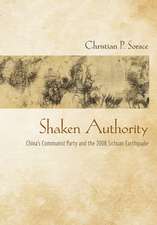NSCA`s Essentials of Tactical Strength and Conditioning
Autor Nsca –national Nscaen Limba Engleză Hardback – 23 feb 2017
Preț: 552.74 lei
Preț vechi: 717.84 lei
-23% Nou
Puncte Express: 829
Preț estimativ în valută:
105.78€ • 114.86$ • 88.85£
105.78€ • 114.86$ • 88.85£
Carte disponibilă
Livrare economică 01-15 aprilie
Livrare express 18-22 martie pentru 87.66 lei
Preluare comenzi: 021 569.72.76
Specificații
ISBN-13: 9781450457309
ISBN-10: 1450457304
Pagini: 688
Dimensiuni: 222 x 298 x 38 mm
Greutate: 2.18 kg
Editura: MG – Human Kinetics
ISBN-10: 1450457304
Pagini: 688
Dimensiuni: 222 x 298 x 38 mm
Greutate: 2.18 kg
Editura: MG – Human Kinetics
Cuprins
Chapter 1: Tactical Strength and Conditioning: An Overview
Brent A. Alvar, PhD, CSCS,*D, RSCC*D, FNSCA
Katie Sell, PhD, CSCS,*D, TSAC-F
Patricia A. Deuster, PhD, MPH, CNS
NSCA TSAC Program
Duties of a Tactical Athlete
Job Analysis of a Tactical Athlete
Assessment of the Individual
Program Design
Chapter 2: Cardiopulmonary and Endocrine Responses and Adaptations to Exercise
Denise Smith, PhD
Cardiovascular Structure and Function
Pulmonary Anatomy and Function
Acute Cardiovascular Responses to Exercise
Acute Respiratory Responses to Exercise
Acute Endocrine Responses to Exercise
Chronic Adaptations of the Cardiopulmonary and Endocrine Systems to Exercise and High-Stress Situations
Chapter 3: Skeletal Muscle Anatomy and Biomechanics
Michael R. Deschenes, PhD
Raymond W. McCoy, PhD
Bones and the Skeleton
Skeletal Muscle
Muscle Mechanics
Neuromuscular Anatomy
Neural Responses During Exercise
Biomechanical Principles
Types of Muscle-Strengthening Exercises
Biomechanical Factors Affecting Muscle Strength
Chapter 4: Physiological Adaptations and Bioenergetics
Todd Miller, PhD, CSCS,*D, TSAC¿F, FNSCA
Bioenergetics and Metabolism
Physiological Adaptations to Exercise
Detraining and Retraining
Chapter 5: Basic Nutrition for Tactical Populations
Steve Hertzler, PhD, RD, LD
Amanda Carlson-Phillips, MS, RD, CSSD
Guidelines for Dispensing Nutrition Information
Step 1: Understand the Demands of the Tactical Athlete
Step 2: Understand Basic Fueling Concepts
Step 3: Provide Nutritional Guidance
Step 4: Create Nutritional Recommendations to Support Performance and Recovery
Providing Guidance on Energy Balance and Nutrition Tools
Chapter 6: Tactical Fueling
Maj. Nicholas D. Barringer, PhD, RD, CSCS,*D, CSSD
Maj. Aaron P. Crombie, PhD, RD
Nutritional Needs of Tactical Athletes
Nutrient Requirements of Tactical Athletes Under Various Conditions
Nutrition-Related Conditions and Chronic Diseases of Tactical Athletes
Chapter 7: Ergogenic Aids
Abbie E. Smith-Ryan, PhD, CSCS,*D, FNSCA
Colin D. Wilborn, PhD, CSCS, ATC
Eric T. Trexler, MA, CSCS
Regulation of Dietary Supplements
Anti-Doping Agencies and Dietary Supplement Resources
Risk Stratification of Supplements
Common Performance-Enhancing Substances: Potential Benefits, Risks, and Side Effects
Illegal Performance-Enhancing Substances
Signs and Symptoms of Ergogenic Aid Abuse
Chapter 8: Testing and Evaluation of Tactical Populations
Bradley J. Warr, PhD, MPAS
Patrick Gagnon, MS
Dennis E. Scofield, MEd, CSCS
Suzanne Jaenen, MS
History of Fitness Testing in Tactical Occupations
Types of Performance Tests
Testing Procedures
Evaluation of Performance Test Results
Use of Performance Test Results
Chapter 9: Development of Resistance Training Programs
Nicholas A. Ratamess, PhD, CSCS,*D, FNSCA
Needs Analysis
Resistance Training Program Design
Chapter 10: Periodization for Tactical Populations
G. Gregory Haff, PhD, CSCS,*D, FNSCA, ASCC
Defining Periodization
Goals of Periodization
Principles of Periodization Models
Structural Components of Periodized Training
Sequencing and Integrating Training
Applying Periodization Theory to Deployment-Based Tactical Athletes
Applying Periodization Theory to Nondeployed Tactical Athletes
Chapter 11: Resistance Training Exercise Techniques
Jason Dudley, MS, CSCS,*D, TSAC¿F, RSCC, FMS¿1, USAW¿1
Brad Schoenfeld, PhD, CSCS, NSCA¿CPT, FNSCA
Performing Exercises With Alternative Implements
Warm-Up Before Resistance Training
Guidelines on Body Stance and Alignment, Breathing, and Spotting
Resistance Training Exercises
Chapter 12: Flexibility and Mobility Exercise Techniques and Programming
Mark Stephenson, MS, ATC, CSCS,*D, TSAC-F
Daniel J. Dodd, PhD, CSCS
Comparison of Mobility and FlexibilityTypes of Flexibility and Mobility Exercises
Exercise Technique and Cueing Guidelines
Program Design
Chapter 13: Plyometric, Speed, and Agility Exercise Techniques and Programming
Mike Barnes, MEd, CSCS, NSCA¿CPT
Jay Dawes, PhD, CSCS,*D, NSCA¿CPT,*D, FNSCA
Plyometric Training
Speed Training
Agility Training
Chapter 14: Aerobic Endurance Exercise Techniques and Programming
Matthew R. Rhea, PhD, CSCS,*D
Brent A. Alvar, PhD, CSCS,*D, RSCC*D, FNSCA
Warming Up Before Aerobic Endurance Training
Exercise Techniques and Cueing Guidelines
Step 1: Exercise Mode
Step 2: Training Frequency
Step 3: Training Intensity
Step 4: Exercise Duration
Step 5: Exercise Progression
Program Design Recommendations
Chapter 15: Evidence-Based Approach to Strength and Power Training to Improve Performance in Tactical Populations
Dennis E. Scofield, MEd, CSCS
Sarah E. Sauers, MS, CSCS
Barry A. Spiering, PhD, CSCS
Marilyn A. Sharp, MS
Bradley C. Nindl, PhD
Overview of Occupational Demands
Optimizing Occupational Performance
Applying Principles of Strength and Power Training
Chapter 16: Care and Rehabilitation of Injured Tactical Populations
Danny McMillian, PT, DSc
Common Injury Prevalence and Risk Factors
Phases of Tissue Healing
Causes, Signs, and Symptoms of Overtraining Syndrome
Maintenance of Training Status During Rehabilitation and Reconditioning
Guidelines for Injury Care and Rehabilitation
Chapter 17: Physiological Issues Related to Fire and Rescue Personnel
Katie Sell, PhD, CSCS,*D, TSAC-F,*D
Mark Abel, PhD, CSCS,*D, TSAC-F,*D, USAW
Joseph Domitrovich, PhD
Critical Job Tasks for Firefighters
Environmental, Occupational, and Exposure Concerns
Injury and Illness Risks in Firefighters
Optimizing Functional Fitness
Program Design and Sample Training Approaches
Chapter 18: Physiological Issues Related to Law Enforcement Personnel
Ben Hinton, MSc, CSCS
Sgt Mick Sterli, BPhysEd, MExSc, CSCS,*D, TSAC¿F,*D
Robin Orr, PhD, MPhty, BFET, TSAC-F
Critical Job Tasks for Law Enforcement Personnel
Environmental, Occupational, and Exposure Concerns
Injury and Illness Risks
Optimizing Functional Fitness
Key Program Variables
Chapter 19: Physiological Issues Related to Military Personnel
William Kraemer, PhD, CSCS,*D, FNSCA
LTC David Feltwell, PT, OCS, TSAC-F
Tunde Szivak, PhD, CSCS
Critical Job Tasks for Conventional Military and Special Operations Personnel
Environmental, Occupational, and Exposure Concerns
Injury and Illness Risks
Optimizing Functional Fitness
Program Design and Sample Training Approaches
Chapter 20: Physical Training to Optimize Load Carriage
Paul C. Henning, PhD, CSCS
Barry A. Spiering, PhD, CSCS
Dennis E. Scofield, MEd, CSCS
Bradley C. Nindl, PhD
Impact of Equipment Load on Biomechanical Demands
Physiological and Biomechanical Demands of Load Carriage
Practical Considerations for Training Programs to Optimize Load Carriage
Chapter 21: Wellness Interventions in Tactical Populations
Robin Orr, PhD, MPhty, BFET, TSAC-F
John R. Bennett, MS, CSCS, EMT-P
Chronic Illness and Diseases Conditions Common in Tactical Populations
Risk Factors Requiring Wellness Interventions
Operating Wellness Programs for Tactical Populations
Chapter 22: Organization and Administration Considerations
John Hofman, Jr, MS, CSCS, USAW, USA T&F, FMS
Frank A. Palkoska, MS, CSCS
Design
Layout and Organization
Policies and Procedures
Safe Training Environment
Brent A. Alvar, PhD, CSCS,*D, RSCC*D, FNSCA
Katie Sell, PhD, CSCS,*D, TSAC-F
Patricia A. Deuster, PhD, MPH, CNS
NSCA TSAC Program
Duties of a Tactical Athlete
Job Analysis of a Tactical Athlete
Assessment of the Individual
Program Design
Chapter 2: Cardiopulmonary and Endocrine Responses and Adaptations to Exercise
Denise Smith, PhD
Cardiovascular Structure and Function
Pulmonary Anatomy and Function
Acute Cardiovascular Responses to Exercise
Acute Respiratory Responses to Exercise
Acute Endocrine Responses to Exercise
Chronic Adaptations of the Cardiopulmonary and Endocrine Systems to Exercise and High-Stress Situations
Chapter 3: Skeletal Muscle Anatomy and Biomechanics
Michael R. Deschenes, PhD
Raymond W. McCoy, PhD
Bones and the Skeleton
Skeletal Muscle
Muscle Mechanics
Neuromuscular Anatomy
Neural Responses During Exercise
Biomechanical Principles
Types of Muscle-Strengthening Exercises
Biomechanical Factors Affecting Muscle Strength
Chapter 4: Physiological Adaptations and Bioenergetics
Todd Miller, PhD, CSCS,*D, TSAC¿F, FNSCA
Bioenergetics and Metabolism
Physiological Adaptations to Exercise
Detraining and Retraining
Chapter 5: Basic Nutrition for Tactical Populations
Steve Hertzler, PhD, RD, LD
Amanda Carlson-Phillips, MS, RD, CSSD
Guidelines for Dispensing Nutrition Information
Step 1: Understand the Demands of the Tactical Athlete
Step 2: Understand Basic Fueling Concepts
Step 3: Provide Nutritional Guidance
Step 4: Create Nutritional Recommendations to Support Performance and Recovery
Providing Guidance on Energy Balance and Nutrition Tools
Chapter 6: Tactical Fueling
Maj. Nicholas D. Barringer, PhD, RD, CSCS,*D, CSSD
Maj. Aaron P. Crombie, PhD, RD
Nutritional Needs of Tactical Athletes
Nutrient Requirements of Tactical Athletes Under Various Conditions
Nutrition-Related Conditions and Chronic Diseases of Tactical Athletes
Chapter 7: Ergogenic Aids
Abbie E. Smith-Ryan, PhD, CSCS,*D, FNSCA
Colin D. Wilborn, PhD, CSCS, ATC
Eric T. Trexler, MA, CSCS
Regulation of Dietary Supplements
Anti-Doping Agencies and Dietary Supplement Resources
Risk Stratification of Supplements
Common Performance-Enhancing Substances: Potential Benefits, Risks, and Side Effects
Illegal Performance-Enhancing Substances
Signs and Symptoms of Ergogenic Aid Abuse
Chapter 8: Testing and Evaluation of Tactical Populations
Bradley J. Warr, PhD, MPAS
Patrick Gagnon, MS
Dennis E. Scofield, MEd, CSCS
Suzanne Jaenen, MS
History of Fitness Testing in Tactical Occupations
Types of Performance Tests
Testing Procedures
Evaluation of Performance Test Results
Use of Performance Test Results
Chapter 9: Development of Resistance Training Programs
Nicholas A. Ratamess, PhD, CSCS,*D, FNSCA
Needs Analysis
Resistance Training Program Design
Chapter 10: Periodization for Tactical Populations
G. Gregory Haff, PhD, CSCS,*D, FNSCA, ASCC
Defining Periodization
Goals of Periodization
Principles of Periodization Models
Structural Components of Periodized Training
Sequencing and Integrating Training
Applying Periodization Theory to Deployment-Based Tactical Athletes
Applying Periodization Theory to Nondeployed Tactical Athletes
Chapter 11: Resistance Training Exercise Techniques
Jason Dudley, MS, CSCS,*D, TSAC¿F, RSCC, FMS¿1, USAW¿1
Brad Schoenfeld, PhD, CSCS, NSCA¿CPT, FNSCA
Performing Exercises With Alternative Implements
Warm-Up Before Resistance Training
Guidelines on Body Stance and Alignment, Breathing, and Spotting
Resistance Training Exercises
Chapter 12: Flexibility and Mobility Exercise Techniques and Programming
Mark Stephenson, MS, ATC, CSCS,*D, TSAC-F
Daniel J. Dodd, PhD, CSCS
Comparison of Mobility and FlexibilityTypes of Flexibility and Mobility Exercises
Exercise Technique and Cueing Guidelines
Program Design
Chapter 13: Plyometric, Speed, and Agility Exercise Techniques and Programming
Mike Barnes, MEd, CSCS, NSCA¿CPT
Jay Dawes, PhD, CSCS,*D, NSCA¿CPT,*D, FNSCA
Plyometric Training
Speed Training
Agility Training
Chapter 14: Aerobic Endurance Exercise Techniques and Programming
Matthew R. Rhea, PhD, CSCS,*D
Brent A. Alvar, PhD, CSCS,*D, RSCC*D, FNSCA
Warming Up Before Aerobic Endurance Training
Exercise Techniques and Cueing Guidelines
Step 1: Exercise Mode
Step 2: Training Frequency
Step 3: Training Intensity
Step 4: Exercise Duration
Step 5: Exercise Progression
Program Design Recommendations
Chapter 15: Evidence-Based Approach to Strength and Power Training to Improve Performance in Tactical Populations
Dennis E. Scofield, MEd, CSCS
Sarah E. Sauers, MS, CSCS
Barry A. Spiering, PhD, CSCS
Marilyn A. Sharp, MS
Bradley C. Nindl, PhD
Overview of Occupational Demands
Optimizing Occupational Performance
Applying Principles of Strength and Power Training
Chapter 16: Care and Rehabilitation of Injured Tactical Populations
Danny McMillian, PT, DSc
Common Injury Prevalence and Risk Factors
Phases of Tissue Healing
Causes, Signs, and Symptoms of Overtraining Syndrome
Maintenance of Training Status During Rehabilitation and Reconditioning
Guidelines for Injury Care and Rehabilitation
Chapter 17: Physiological Issues Related to Fire and Rescue Personnel
Katie Sell, PhD, CSCS,*D, TSAC-F,*D
Mark Abel, PhD, CSCS,*D, TSAC-F,*D, USAW
Joseph Domitrovich, PhD
Critical Job Tasks for Firefighters
Environmental, Occupational, and Exposure Concerns
Injury and Illness Risks in Firefighters
Optimizing Functional Fitness
Program Design and Sample Training Approaches
Chapter 18: Physiological Issues Related to Law Enforcement Personnel
Ben Hinton, MSc, CSCS
Sgt Mick Sterli, BPhysEd, MExSc, CSCS,*D, TSAC¿F,*D
Robin Orr, PhD, MPhty, BFET, TSAC-F
Critical Job Tasks for Law Enforcement Personnel
Environmental, Occupational, and Exposure Concerns
Injury and Illness Risks
Optimizing Functional Fitness
Key Program Variables
Chapter 19: Physiological Issues Related to Military Personnel
William Kraemer, PhD, CSCS,*D, FNSCA
LTC David Feltwell, PT, OCS, TSAC-F
Tunde Szivak, PhD, CSCS
Critical Job Tasks for Conventional Military and Special Operations Personnel
Environmental, Occupational, and Exposure Concerns
Injury and Illness Risks
Optimizing Functional Fitness
Program Design and Sample Training Approaches
Chapter 20: Physical Training to Optimize Load Carriage
Paul C. Henning, PhD, CSCS
Barry A. Spiering, PhD, CSCS
Dennis E. Scofield, MEd, CSCS
Bradley C. Nindl, PhD
Impact of Equipment Load on Biomechanical Demands
Physiological and Biomechanical Demands of Load Carriage
Practical Considerations for Training Programs to Optimize Load Carriage
Chapter 21: Wellness Interventions in Tactical Populations
Robin Orr, PhD, MPhty, BFET, TSAC-F
John R. Bennett, MS, CSCS, EMT-P
Chronic Illness and Diseases Conditions Common in Tactical Populations
Risk Factors Requiring Wellness Interventions
Operating Wellness Programs for Tactical Populations
Chapter 22: Organization and Administration Considerations
John Hofman, Jr, MS, CSCS, USAW, USA T&F, FMS
Frank A. Palkoska, MS, CSCS
Design
Layout and Organization
Policies and Procedures
Safe Training Environment
Notă biografică
Descriere
NSCA's Essentials of Tactical Strength and Conditioning is the ideal preparatory guide for those seeking TSAC-F certification. The book is also a great reference for fitness trainers who work with tactical populations such as military, law enforcement, and fire and rescue personnel.
























